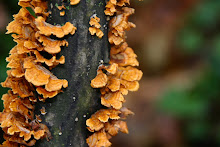
We park across from the Golf Clubhouse, stopping to notice for the first time lichens growing on the stones on the Lick Creek bridge. Stopping for a moment and then we walk into the woods through milky light from a weak sun.
 Just inside the woods, the trenched path is filled with water, water stretches as far as we can see. A robin at the edge tosses leaves to the side, looking for worms in the wet ground.
Just inside the woods, the trenched path is filled with water, water stretches as far as we can see. A robin at the edge tosses leaves to the side, looking for worms in the wet ground.

The further we go, the more robins we see, drawn there by the soggy, unpoisoned ground.

We walk carefully, along the trails dryer edge, along the submerged stretches. At other places the trail has been churned to a muddy slog by feet – human and dog – and bicycle tires.

Looking up through a tangle of bare limbs, I see a moon white twisting sycamore tree.
Nearby a red cardinal chips on a fallen tree trunk.
Escaping the trail turned creek, we step out onto the asphalt path that connects the two eastern golf link, dodging long puddles in the shallow parts. Beside the path, a sycamore stands, its peeled bark caught mid-fall by poison ivy vines.

Back in the woods, we stumble across a jumble of limbs, piled there after a storm. Mushrooms grow on one of the limbs, half of them pointing their thin top edges north, half pointing south, as neat divided as parted hair.

Maybe it’s the wet and the warmer weather over the last week, but there is so much lichen growing in the woods, growing on the sides of living and dead trees, over roots on the ground.
This place is so still and open, even though it’s in the middle of Memphis.

A male goldfinch bobs past, lands on a thin limb. It’s still early in the year and his feathers have just the faintest green glow.

Throughout the walk, we keep noticing swelling buds, and early leaf shoots, young and wine red.
At another place we find, mostly buried in the leaves, a green shoot, like some blind bald caterpillar lifting itself out of the ground.

The trail is wet, and the soggy low areas and drier upland trails make me aware of the shape of the woods below my feet.
Walking along the eastern edge of the woods and the shrieks of children on the playground along East Parkway slice through the bare undergrowth and find us here. Somewhere deeper into the woods, a hidden bird gives a throaty laugh.
We turn away from the sounds of children, walking toward to the center of the woods, stopped by a black cherry, an old gash in its bark, its scar faded to ashen gray.

We walk.
Past tiny orange-brown mushrooms growing in the hollow spaces of a fallen log.

We find other mushrooms, some dry and brown, some white-fleshed with red borders.

On one tree, shelved mushrooms glow green with lichen.

Nearby, shoots from underground bulbs erupt from the leaves.

In the leafless winter, we see old grape vines dangling from high tree limbs, their original supports gone now, making them look as though they have grown backwards, starting on the tree and slowly reaching their way down to root themselves into the ground.

In another place, a dead vine binds two briars together.

Nearby, sunlight fired the leaves of a cherry laurel.

We walk through the afternoon, until we find ourselves on the other side of the woods, on the road closest to the parking lot beside the Greensward.
Sweet gum balls lay scattered on the pavement.

Leaving, we walk along the road, on the gravel path skirting the golf course, watching the clouds drift over us.

Words by Stephen Black
Photos by Jenn Allmon



































